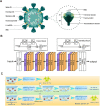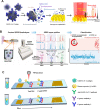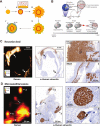Recent development of surface-enhanced Raman scattering for biosensing
- PMID: 37149605
- PMCID: PMC10163864
- DOI: 10.1186/s12951-023-01890-7
Recent development of surface-enhanced Raman scattering for biosensing
Abstract
Surface-Enhanced Raman Scattering (SERS) technology, as a powerful tool to identify molecular species by collecting molecular spectral signals at the single-molecule level, has achieved substantial progresses in the fields of environmental science, medical diagnosis, food safety, and biological analysis. As deepening research is delved into SERS sensing, more and more high-performance or multifunctional SERS substrate materials emerge, which are expected to push Raman sensing into more application fields. Especially in the field of biological analysis, intrinsic and extrinsic SERS sensing schemes have been widely used and explored due to their fast, sensitive and reliable advantages. Herein, recent developments of SERS substrates and their applications in biomolecular detection (SARS-CoV-2 virus, tumor etc.), biological imaging and pesticide detection are summarized. The SERS concepts (including its basic theory and sensing mechanism) and the important strategies (extending from nanomaterials with tunable shapes and nanostructures to surface bio-functionalization by modifying affinity groups or specific biomolecules) for improving SERS biosensing performance are comprehensively discussed. For data analysis and identification, the applications of machine learning methods and software acquisition sources in SERS biosensing and diagnosing are discussed in detail. In conclusion, the challenges and perspectives of SERS biosensing in the future are presented.
Keywords: Biological imaging; Biomolecular; Machine learning; SARS-CoV-2; SERS; Tumor.
© 2023. The Author(s).
Conflict of interest statement
The authors declare that they have no competing interests.
Figures











Similar articles
-
Nanofabricated SERS-active substrates for single-molecule to virus detection in vitro: a review.Biosens Bioelectron. 2014 Nov 15;61:232-40. doi: 10.1016/j.bios.2014.05.013. Epub 2014 May 20. Biosens Bioelectron. 2014. PMID: 24892785 Review.
-
SERS-Based Local Field Enhancement in Biosensing Applications.Molecules. 2024 Dec 30;30(1):105. doi: 10.3390/molecules30010105. Molecules. 2024. PMID: 39795162 Free PMC article. Review.
-
Recent Trends in SERS-Based Plasmonic Sensors for Disease Diagnostics, Biomolecules Detection, and Machine Learning Techniques.Biosensors (Basel). 2023 Feb 27;13(3):328. doi: 10.3390/bios13030328. Biosensors (Basel). 2023. PMID: 36979540 Free PMC article. Review.
-
Design and Synthesis of SERS Materials for In Vivo Molecular Imaging and Biosensing.Adv Sci (Weinh). 2023 Mar;10(8):e2202051. doi: 10.1002/advs.202202051. Epub 2023 Jan 22. Adv Sci (Weinh). 2023. PMID: 36683237 Free PMC article. Review.
-
Recent progress in SERS biosensing.Phys Chem Chem Phys. 2011 Jun 28;13(24):11551-67. doi: 10.1039/c0cp01841d. Epub 2011 Apr 21. Phys Chem Chem Phys. 2011. PMID: 21509385 Free PMC article. Review.
Cited by
-
Extracellular Vesicle Preparation and Analysis: A State-of-the-Art Review.Adv Sci (Weinh). 2024 Aug;11(30):e2401069. doi: 10.1002/advs.202401069. Epub 2024 Jun 14. Adv Sci (Weinh). 2024. PMID: 38874129 Free PMC article. Review.
-
Morphology Engineering of SnS2 Nanostructures to Stimulate PICT Resonance for Ultra-Sensitive SERS Sensors.Exploration (Beijing). 2025 Feb 24;5(3):270016. doi: 10.1002/EXP.70016. eCollection 2025 Jun. Exploration (Beijing). 2025. PMID: 40585753 Free PMC article.
-
Principles and Applications of ZnO Nanomaterials in Optical Biosensors and ZnO Nanomaterial-Enhanced Biodetection.Biosensors (Basel). 2024 Oct 6;14(10):480. doi: 10.3390/bios14100480. Biosensors (Basel). 2024. PMID: 39451693 Free PMC article. Review.
-
Biosensors for Cancer Biomarkers Based on Mesoporous Silica Nanoparticles.Biosensors (Basel). 2024 Jun 30;14(7):326. doi: 10.3390/bios14070326. Biosensors (Basel). 2024. PMID: 39056602 Free PMC article. Review.
-
SERS analysis of single cells and subcellular components: A review.Heliyon. 2024 Sep 10;10(18):e37396. doi: 10.1016/j.heliyon.2024.e37396. eCollection 2024 Sep 30. Heliyon. 2024. PMID: 39315187 Free PMC article. Review.
References
-
- Fleischmann M, Hendra PJ, McQuillan AJ. Raman spectra of pyridine adsorbed at a silver electrode. Chem Phys Lett. 1974;26:163–166. doi: 10.1016/0009-2614(74)85388-1. - DOI
-
- Albrecht MG, Creighton JA. anomalously intense raman spectra of pyridine at a silver electrod. J Am Chem Soc. 1977;99:5215–5217. doi: 10.1021/ja00457a071. - DOI
-
- Jeanmaire DL, Vanduyne R. Surface raman spectroelectrochemistry: part I. heterocyclic, aromatic, and aliphatic amines adsorbed on the anodized silver electrode. J Electroanal Chem. 1977;84:1–20. doi: 10.1016/S0022-0728(77)80224-6. - DOI
Publication types
MeSH terms
Grants and funding
LinkOut - more resources
Full Text Sources
Medical
Research Materials
Miscellaneous

